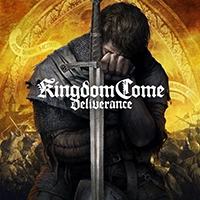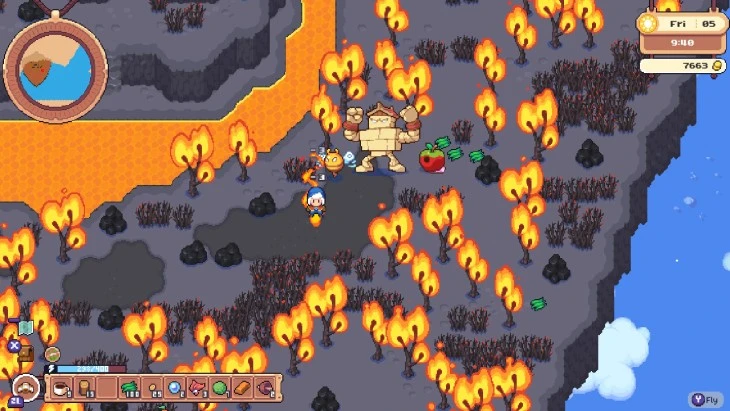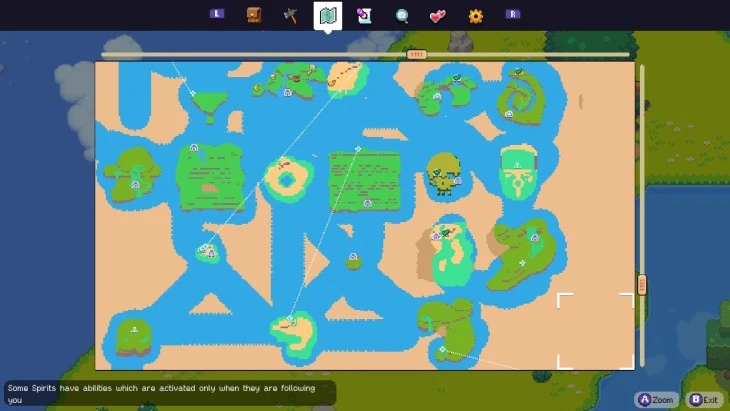
The world of Pokemon is one of the most recognizable and well regarded franchises within the gaming world. It’s no surprise then that there are dozens of games that have popped up over the last few decades seeking to get a slice of the Pikachu pie. One of the latest endeavors, Moonstone Island, recently released on the Nintendo Switch. This adventure combines the creature collection of Pokemon, the artistic whimsy of Studio Ghibli, and select farming sim elements of games like Harvest Moon to a rousing degree of success.
Players begin their journey as a little alchemist who must set out on their own for one year and find an island in the sky to call their new home. Alchemists are in charge of collecting and taming spirits, various creatures who belong to one of eight types and can be utilized in combat against other spirits. On your new home, you will have the ability to make friends with the island inhabitants, explore the 100 neighboring islands, and tame a variety of wild spirits.

While most of the islands are green, some of the tougher, more elusive creatures and plants hide out on elemental islands.
The story of Moonstone Island is cozy, but it has a few pitfalls depending on what kind of gaming experience you are looking for. The overarching story is a little weak, with more emphasis placed on getting to know your neighbors, farming and fishing. Although the game features four temples for the alchemist to make their way through, there is little else plot-wise to drive things forward. Gamers who are accustomed to a string of gym leaders and an elite four-style ending might feel a little underwhelmed at times. Thus, Moonstone Island feels like the perfect game for those seeking a more relaxed creature capturing experience.
Additionally, the developers lean a little too hard into their Ghibli influences at times. The beginning, where the alchemist leaves their parents and sets out on their own, comes straight out of Kiki’s Delivery Service, broom break and all. There’s also a wizard man with a moving castle who you can occasionally find while exploring islands. Moonstone Island is at its best when it’s using its influences for music or art style, and can feel cheap when pulling from plot beats.
Over the course of your year and beyond, Moonstone Island provides a variety of gameplay mechanics and social simulation. This allows for players to enjoy it as a Pokemon-like game with social and farming elements, in case you are new to the genre or would rather have a more relaxing experience.
Because Moonstone Island is modeled after Pokemon, there is a combat system in place. However, the way the games approach this element are vastly different. This game uses a deckbuilding system to give each spirit a variety of attacks and buffs. Alchemists can have up to 3 spirits with them at a time. Each turn in combat they are presented with a random pull of cards from across their current companions. Learning how each card works and when to play each one provides a nice challenge at first before allowing players to settle into a rhythm.
Another important mechanic in combat is breaking shields. Each spirit has a shield level that helps protect against elemental attacks. Basic attacks will often be able to bypass the shield and cause damage, though to a lesser extent than indicated on the card. Some creatures, like the Guardians found in dungeons across the map, are seemingly immune to non-elemental damage. Shields can be broken by using a card that explicitly breaks opponent’s shields. Occasionally, some spirits who are weak to an element will take damage to their shield instead of themselves when that element is used against them. Finding a balance between damage and shield-breaking cards your deck, as well as adapting your strategy for each spirit, helps keep the combat from getting too repetitive.
Similarly to the game it is emulating, the alchemist must choose from one of three spirits to start their journey with. While you must start with electric, earth, or fire, after you begin exploring you will also encounter water, dark, poison, ice and psychic spirits that you can tame and utilize. Each type also has strengths and weaknesses against other spirit types. Throughout the game there are over 60 varieties of spirits, and each spirit has a holographic form that features a different color scheme and stats. To collect them all, alchemists must collect or grow plants and feed them to opponents during combat. If the opposing spirit is low enough level, after the spirit is fed enough it is considered tamed.
Your parents give you a special amulet which allows you to keep your three closest spirits with you at all times. Any spirits beyond that are sent to the local researcher or your barn, once you have built one. The barn allows players to keep a significant number of spirits, feeding them and even leveling them up. Players can also hatch and raise eggs they have found here. In return, each type of spirit has a special dropping that alchemists can collect and use for resources. For example, earth spirits drop clay while dark spirits drop dark matter. Between the droppings and the ability to switch between a variety of different spirits easily, the barn is a worthy addition to the creature-catching genre and helps give Moonstone Island a cozy feeling.
Our POV character’s new home comes with a vast expanse of sky and other islands to explore. Players can fly via balloon, broom, or glider to visit the other land masses across a huge map. While some islands are normal, many are themed to elements and feature special flora that can be fed to spirits, both friend and foe. Several also feature dungeons that players can explore for treasure, if they’re brave enough.
Exploring is one of the most innovative parts of Moonstone Island. Players will only be able to reach close islands at first, but will slowly gain better equipment and increase their stamina. As they venture further out, it’s incredibly satisfying to watch the fog of war disappear from the map and find resources that will increase the power of your companions. Sometimes you might even reach an island with creatures far too powerful for your level. The accompanying rush of adrenaline helps ensure the exploration never gets tiresome.
The titular moonstones are special blue orbs that players will encounter as they venture across the sky islands. Every single island has one, and they are valuable to the alchemist. Collecting enough will allow players to craft better items, in turn improving how far they can explore or how good they are at collecting resources. While moonstones glow in the dark, they can be tricky to find if you’re not working at night. One quality of life feature that the game would hugely benefit from is marking which island’s stones have been found on the map. The map notes which dungeons are completed or where a stamina-restoring hot spring is, so it feels like a strange oversight that this is not included.

As you explore, the map will remove the fog and show some symbols of what you have discovered there.
Moonstone Island also has social simulation elements, meaning it is possible to form relationships with the residents. There are 10 villagers to get to know, plus the wizard man in his moving hut. All of these NPCs are also romanceable, allowing you to take them on dates if you raise their friendship high enough. Players can chat with everyone, give gifts, and even play matchmaker with spirits to earn hearts with the villagers.
While the characters are colorful and fun both in design and personality, it takes a frustratingly long amount of time to get to know them. While you can talk to them casually, the method to obtain points towards more hearts feels awkward and cold. Players have the choice to chat, joke, or flirt, all with a percentage of success attached to them. This rate varies depending on how well you know the character and if you have upgraded the social points on your skill tree. However, when pressing the button you only get red or grey hearts from the NPC’s sprite, no extra dialogue. It genuinely feels like you have to romance most NPCs in order to learn about them. In comparison to the love and work put into the spirits, the people come across as bland and the social simulation elements feel half-baked.
One of the more unique elements of Moonstone Island for the creature-catching genre is the ability to customize your living space. After arriving on the island, you will have the opportunity to build a home and expand on it as time goes by, adding in new rooms and floors or filling it with useful items like furnaces or anvils to assist you in your journey as an alchemist.
Because the home is technically just a pocket dimension, there is a huge variety of options to customize the outside as well. If you have ever wanted to live in a tree fort or a lighthouse, this game has you covered. Another perk of the pocket dimension is that you can build multiple houses across the islands that are all the same place. This allows easy access to items and resources, and comes in handy once you’ve explored a significant portion of the map. Not having to rush back to the main island every time you need something is a breath of fresh air.
In addition to the home and the spirit barn, players also have the option to build a greenhouse near their house. This allows plants and flowers from any season to grow at any time, which will be helpful as you learn which plants work best for healing, buffing, or taming certain spirits. It can also assist you in wooing your NPC of choice, as half of the cast has some kind of flora that they like or even love. While not necessary to succeed in the game, it makes things significantly easier once you have the necessary materials and money to obtain one.
While Moonstone Island opts to lean more simplistic in its graphics, it is still an absolutely gorgeous game. The game uses a slightly pixelated art style with more detailed graphics for the sprites of each character when talking to them. This decision allows the design of the game to shine through, from the unique and diverse cast to the simple yet effective creature concepts. Additionally, the game makes great use of its bright color pallet. The bright blues of the sky and the gorgeous greens of the trees and grass of the home island almost make you feel like you’re outside yourself. It also allows for a fantastic contrast when stumbling across a dark red and black fire island or a sickly yellow electric island. Despite the simplicity, you never feel like you’re exploring the same island twice.
One critique that should be levied at Moonstone Island are the creature designs. Despite their simplicity, all of the designs work well and many are simply adorable. Several of them, like Fishbo or Catsket, are incredibly clever and unique. However, a few of them feel like they don’t take quite enough liberty with the designs and end up overlapping with Pokemon just a bit too much. With over 60 designs in this game and hundreds of Pokemon in existence, it’s understandable to see some overlap. Still, after 20 hours of traveling with Womr and Fluffox, it’s a little hard to retrain your brain from thinking of them as Applin and Fennekin.
The best word that comes to mind to describe the music in this game is “wonderous.” Once again, Moonstone Island carries its influences on its sleeves. The score is a little Ghibli, a little early Zelda, and a dash of Stardew, but somehow comes together to create something entirely unique. It would be easy to dismiss the feelings the OST invokes as preying on nostalgia it didn’t earn, but even tracks that feel wholly original have a sense of mystery and wonder built into them. “Moonlight On The Island”, “Moonstone Rising”, and “Winter Is Around The Corner” especially are standouts. If nothing else, the game is worth playing purely for the invincible feeling you’ll get the first time you take off from the home island using your newly built broom while “Moonstone Rising” plays in the background.
Moonstone Island has a surprising amount of staying power for its concept. While the main focus of the story follows the alchemist for a year, there is no explicit end to their journey. Players can stay on the island, continue with any unfinished quests, and keep fighting and taming spirits. If you want to start over from the beginning, Moonstone Island accounted for that. The game procedurally generates a new map for each save, meaning the next 100 islands are different from the last 100 you explored. The variety in creature types also means that players will be able to experiment with nearly endless team compositions. Whether you’re seeking replayability or endless fun, Moonstone Island has you covered.
Moonstone Island is a perfect fit for a variety of gamers. Its gameplay, cute creature designs, and simplistic art style make it perfect for newcomers to the creature-catching genre or those wanting a more relaxed experience. Veterans might find the gameplay a bit lacking, and those who don’t care for deck builder mechanics might also want to steer clear. Though it can feel somewhat derivative at times, the game treats its inspiration with admirable reverence. It’s rare to find a game that manages to roll up wonder and whimsy in such a cozy little box. If this sounds like it would be up your alley, then fly, don’t walk, to pick up this game on your Nintendo Switch.
Moonstone Island gets an 8.5/10.